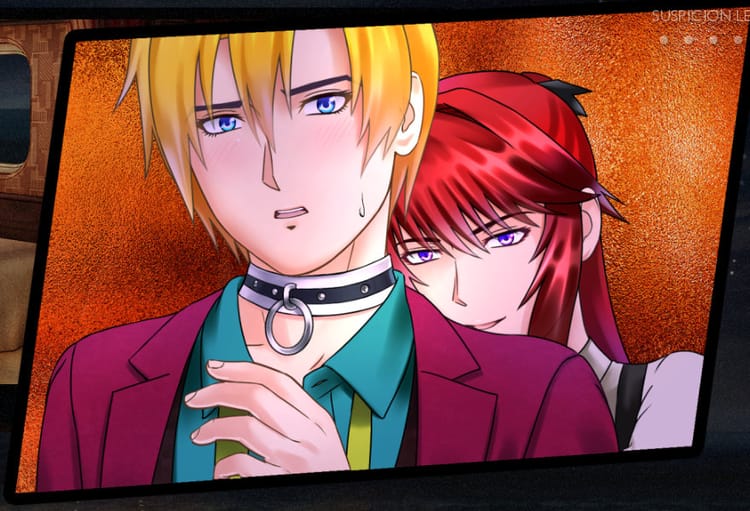Chewing the Cud

Listen, I know some poets, and the last thing those luckless waifs need is more competition for an honest living. The poetry job market has been abysmal for the past two or three millennia. Nonetheless, Ian Bogost—game designer, object-oriented philosopher, game studies luminary, and leading Atari expert—made poets compete with A Slow Year, a set of four “game poems” and 1,024 machined haiku.
The game poems, based on the four seasons, were designed and released as a cartridge in 2010 for the Atari Video Computer System, or Atari 2600, in production from 1977 to 1992. Only 25 cartridges, with deluxe bespoke packaging and signed by Bogost, were produced. There are still nine available for sale, though they’ll set you back a cool $500. For those without an Atari or that kind of scratch (like me), there’s also a paperback book with a CD containing an emulated version for Mac and PC.
Bogost, a professor at Georgia Tech, links A Slow Year to the history of Atari, the Imagist movement in poetry, and haiku. With fellow game scholar Nick Montfort, Bogost literally wrote the book on the Atari: Racing the Beam, which lays bare the constraints of the platform and how developers overcame them. But he’s perhaps best known for Cow Clicker.
The only real challenge is not to drink your coffee too fast.
It’s hard to summarize Cow Clicker, but it’s intimately linked to A Slow Year. The parable goes something like this: Curmudgeonly academic writes a Facebook game about clicking cows to demonstrate that Facebook games are for rubes; rubes and wise-asses embrace the game; academic’s heart and pockets are filled by the rubes’ affection/money; he decides to rapture all the cows and—next thing you know, academic looks surprisingly rugged and handsome as a Wired centerfold. Reading a little into Leigh Alexander’s coverage, it seems A Slow Year and Cow Clicker have a “switched at birth” relationship to each other like The Prince and the Pauper. A Slow Year was born to haughty lineage and care; Cow Clicker was intended as little more than a bastard child raised for spite. But that’s not how it turned out.
While the public and the press couldn’t get enough of the intentional banality of Cow Clicker, when A Slow Year was released, it passed with the fanfare of a quiet fart in polite company. As Bogost said in 2011, “[S]ales of the $500 limited edition have been far easier than sales of the $20 paperback book.” Cow Clicker’s esoteric yokemate seems to have had a hard time finding a general audience. It did much better with critics and the indie avant-garde, qualifying as a finalist for the Independent Games Festival in 2010 and netting Bogost two incredibly badass trophies at IndieCade.
Despite these triumphs, for something Bogost intended as a “provocation machine,” not much has been said about A Slow Year. It deserves a close look as poetry and as a videogame.
/ / /
A Slow Year is structured by a technical numerology. While Dante and other medieval poets looked to numerical patterns in the Bible as a spiritual platform for their poetry, Bogost looks to the hardware limitations and binary nature of the Atari for his. Standard cartridges store only 4 kilobytes of data; each game, representing one season, is 1 kilobyte (1024 bytes). Following a similar logic, there are 256 haiku for each season, for a total of 1,024 machined haiku.
Cathode-ray tube emulation makes the game poems feel like an authentic product of the Atari era. The slight haze that covers the screen, and the way fuzzy blocks of color slightly blend together at the edges, make the screen seem warmer and more organic by giving the solid featureless shapes texture. Sharp LCD screens usually draw attention to the limited resolution of the early systems being emulated, but Bogost’s students have done a remarkable job reproducing the artifacts of CRT. The imperfections of the emulation are the imperfections of the hand-me down ’80s televisions I played Atari on as a kid.
True to the limitations of the Atari system, which had no built-in data for displaying text but relied instead on custom images, there is no text within the game and very little interface. To change between the four games on the Atari, players press a switch. In emulation, players can swap by pressing Tab. In our age of endless menus and update dialogs, it’s nice to be presented with nothing but the pure game.
Autumn
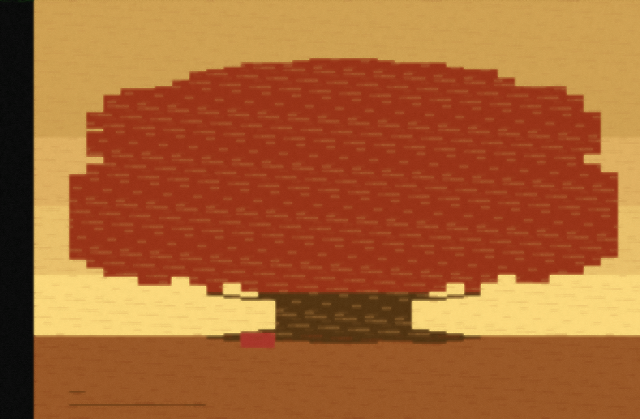
A leaf hangs for a moment before dropping down to the ground, its path determined by the wind that travels in check patterns across the screen. The player controls a red block representing a pile of leaves, and must catch the falling leaf. Given the score at the bottom of the screen and the assuring beep that accompanies successfully catching a leaf in the pile, I did my best to follow Bogost’s advice in the book and treat the experience as “really a game.” Despite my efforts, I realized after a few attempts that I was clenching my teeth with frustration.
While the other games establish a soothing rhythm, in Autumn waiting becomes tense and anxious. The 17 syllables of the haiku form could not contain the torrent of curses I had for Bogost and Autumn as I tried again and again to catch all eight leaves. I started to decipher the source of my frustration. When the lone leaf falls, the pile of leaves freezes in place: the player cannot react to the path of the leaf, likely due to the technical limitations on total moving sprites on the Atari. Sometimes the wind changes direction just a few frames before the leaf falls and freezes the player’s control, making it impossible to catch.
After I realized the game was rigged against me, I took my hands off the keyboard, watched, and listened to the static of the wind across the tree, and took in the subtle golds of the sky beyond. I let the leaves fall.
Winter
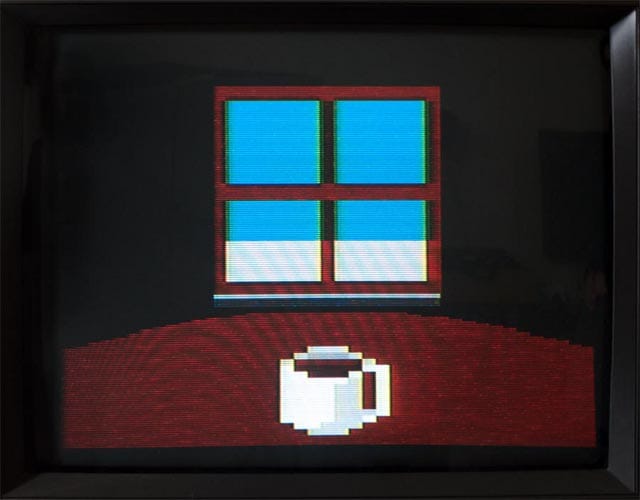
Winter is the game poem that best expresses Bogost’s theme of slowness: he developed A Slow Year at a leisurely pace, and asks the player to experience it in the same spirit. There are no environmental sounds, just a hissing rendition of a slurp when the player chooses to take a sip of coffee by pressing a button. The only real challenge is not to drink your coffee too fast.
The game begins with a full, hot cup of coffee and the darkness of a cold winter morning out the window. As time goes on, the sun rises and the color of the sky lightens and warms. If you gulp the coffee down in the beginning and leave just a splash, it quickly grows cold. As you drink, a simple thermometer displays the coffee’s temperature—let it get too cold, and the game ends.To see the sunrise, you have to sip methodically. On a real joystick, pulling back the stick mimics tilting a coffee cup to take a sip. In one kilobyte, Winter is a surprisingly accurate simulation of drinking coffee.
This season best takes advantage of the beautiful color range of the Atari, from a subtle range of blues to a shock of magenta. The overlap between the blocks of color conveys a remarkable sense of depth to the view outside, giving a glow of light to the edges of the window frame. By making the transitions between colors abrupt, Winter emphasizes the strange colors of dawn that seem normal because nature introduces them so gradually. When the sun finally rises, when you have mastered the discipline of savoring the cup of coffee, and you realize the world outside is blanketed in a stark layer of snow, the game poem conveys a sense of cold better than Skyrim.
Spring
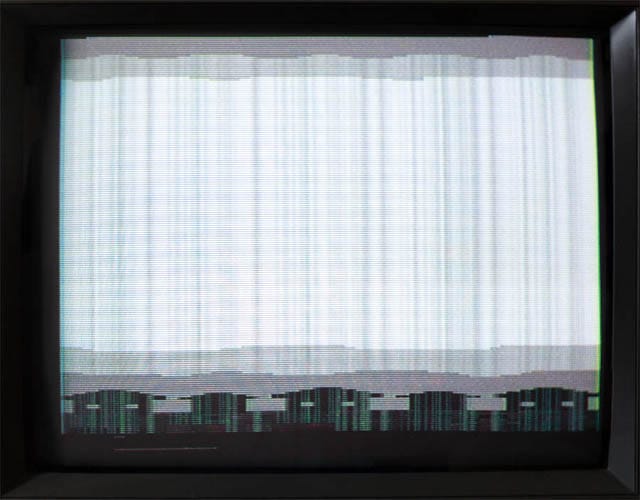
This game poem is about watching the rain, and given the humble squawks of the VCS, it does an admirable job of capturing its sound. There’s a deep monotonous fuzz punctuated by staccato squeals, which emulate the distant roar of heavy rainfall and the splash of nearby puddles. The screen is filled with rapidly alternating shades of gray, torrents of rain falling on a few squatted buildings. The player’s task is to watch for lightning and then press and hold the button from the time of the flash to the clap of thunder. The yellow line of lightning lasts for just a moment; look away and you might not even know you missed it.
At first, it’s hard to see much besides the long skinny blocks of gray. After a while, I let my eyes lose focus and the sharp lines faded into sheets of oncoming rain. I found Spring the most meditative of the seasons; it required patience and quick response, but unlike Autumn’s hanging leaf and changing wind, there was no need to plan or anticipate. The player is always prepared in Spring. In the long intervals between flashes, all I had to do was listen and watch, and then react.
Summer
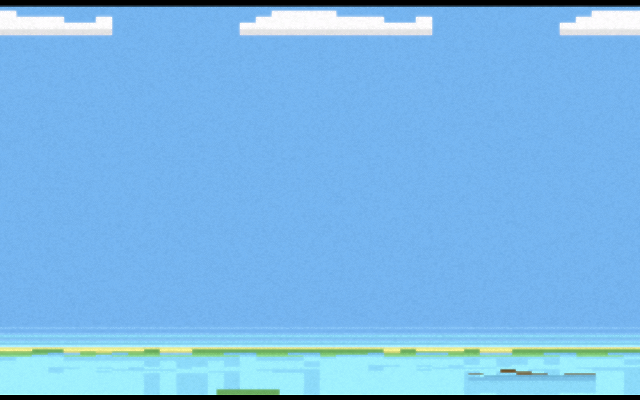
The player watches a log float downstream; the water shimmers and clouds pass slowly overhead. Given the platform, it’s easy to imagine the stream as an isometric view of the Frogger landscape, especially because the pulsing audio sounds like the chirp of crickets. A short green bar represents the player’s gaze. Pressing the button causes the player’s eyelids to slowly droop shut, leaving the screen black. Your task is to doze off. At first, I simply closed my eyes at random intervals, hoping to stumble upon the right pattern. The trick is to close one’s eyes and open them when the log, which moves at a steady rate, is at the point where the green barrests. I realized the chirps came at regular intervals, and I closed my eyes and counted.
For real, though. I actually closed my physical eyes and counted, and when I opened them back up again I felt like an idiot. But it speaks to the immersive power of simulating eyelids, and the visual similarity between closing one’s eyes in real life and within the game world. Once I started pressing the button and keeping my real eyes open (to stare into a black screen), the task was easy.
But it didn’t feel much like the easy grace of slipping off into an afternoon nap. If anything, having to keep track of when to “open my eyes” felt like waiting for my morning alarm to sound.
Machined Haiku
In the essay “Provocation Machines,” Bogost makes an apt comparison between the game poems of A Slow Year and Imagist poetry. To realize his vision, he has caressed every ounce of expressive capacity out of a system forsaken 20 years ago by its manufacturer with remarkable results.
But Bogost’s machined haiku lack the same economy and minimalism that characterize his game poems, and suffer in the inevitable comparison. For one, there are over a thousand of them, taking up a little more than 100 pages. I opened the paperback book to read them between play sessions, but I never felt they contributed richer meaning to the game poems. Their randomness is too apparent; they read more like Dadaist word salad than the carefully shined gems of the Imagists. In the book they are presented one after the other, looking more like stanzas than freestanding poems. As presented, it’s too easy to grind through them, looking for a gem, rather than giving them the moment of careful reflection the terseness of the haiku requires.
Just as few poems have one explicit and ideal reading, few games have an obvious, ideal playthrough.
While Bogost carefully contextualizes the game poems in the included essays, he explains relatively little about the machined haiku. He tells us that he wrote a program to create them, and that he feels writing them by hand would have forced his own interpretations on the player. This seems like a strange reversal of his position a few pages before, where he embraced the role of the author as establishing a situation and constraints within which the audience creates meaning. It’s hardly reassuring when Bogost introduces the machined haiku by admitting, “if you have a book, something has to fill its pages.”
The haiku form, typically themed by season, is not an inherently poor choice. Its syllabification and purposeful ambiguity are better suited to computer generation than most forms of poetry. More traditional haiku even feature a set of recurring words associated with the appropriate seasons, known as saijiki, a word bank from which to generate haiku. But too many esoteric, high-dollar words populate Bogost’s saijiki, and their repetition is strikingly artificial. Over and over again, his haiku are filled with words like herbage, verdure, chalice, dregs, and apparatus. Almost every adverb is jarring or vaguely related to the poem, and the inclusion of the adjectival form of each season (e.g., autumnal, hibernal, vernal, estival) seems contrary to the evocative purpose of haiku. There are also a few strange errors: weird plurals like “deers” and “darks” and double negations like “ununtaut.” Too often, these strange choices hardly seem to mean anything. Take Haiku 354:
The haze assures glows
A cold pinpoints outside ice
Black even if dark
Haiku poet Matsuo Bash? famously said, “The haiku that reveals 70 to 80 percent of its subject is good. Those that reveal 50 to 60 percent, we never tire of.” Unfortunately, the machined haiku seem more often closer to 30 or 40 percent, and suffer for it.
Bogost suggests readers ignore the haiku if they please, and given that the games are far more evocative and carefully crafted, players without a deep interest in machine-generated poetry should focus on the game poems.
/ / /
On one front, the poets are safe. It seems the haiku machine is still inferior to the human author. Yet Bogost’s A Slow Year is strong evidence for his argument that games and poems are both provocation machines that allow free movement within a system. Just as few poems have one explicit and ideal reading, few games have an obvious, ideal playthrough. Both systems allow their audience to create meaning, explore possibilities, and speculate on the world around them.
The greatest strength of game poems may be that they encourage their audience to see the poetic aspects of abstraction and condensation in all games. As Bogost notes, Jonathan Blow’s Braid condenses the experience of regret into a mechanic of time reversal. BioShock even critiqued this condensation with a legendary plot twist that made players question their agency. It’s easy to think of games as imperfect simulations of reality that can be perfected by more processing power and greater graphical fidelity. A Slow Year emphasizes that the meaning and emotion a player invests in play matters more than photorealism or lifelike physics.



